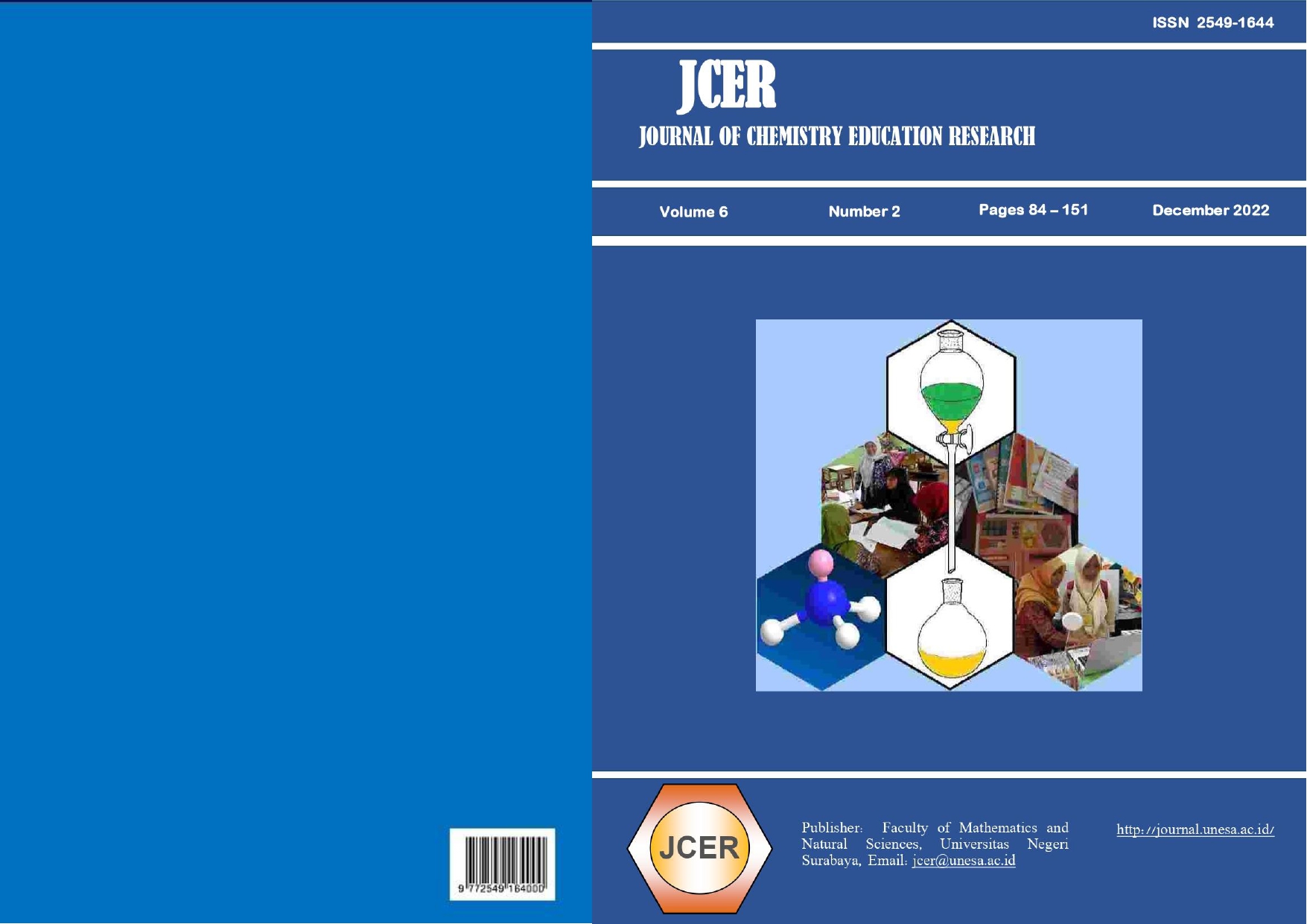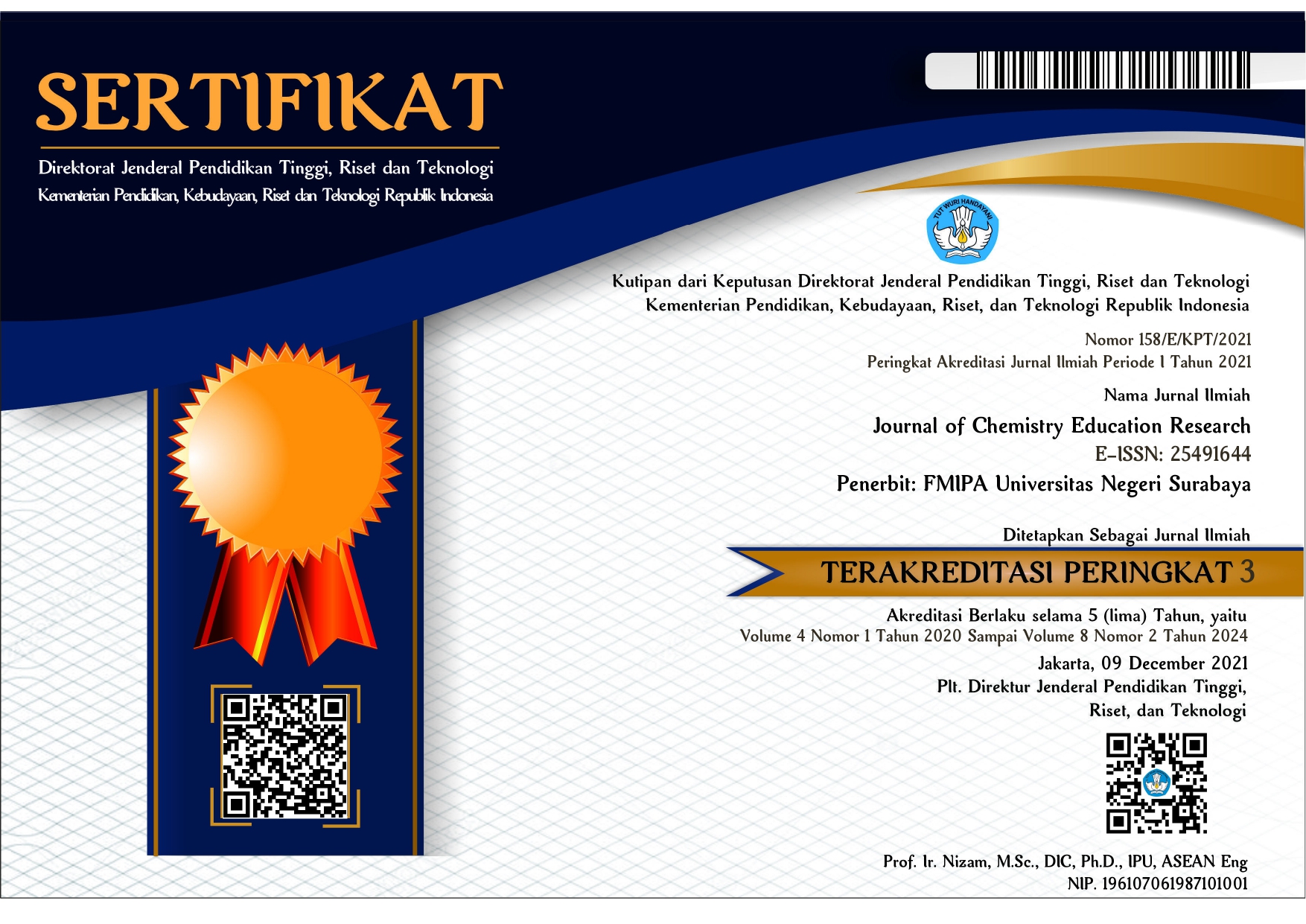IMPACT OF EXPLICIT SCIENTIFIC INQUIRY INSTRUCTION HYBRID MODE WITH SOCIOSCIENTIFIC ISSUE CONTEXT ON STUDENTS’ CRITICAL THINKING SKILLS IN CHEMICAL KINETICS
DOI:
https://doi.org/10.26740/jcer.v6n2.p131-137Keywords:
esii; ssi; hybrid learning; critical thinking, chemical kineticsAbstract
This study aimed to explore whether Explicit Scientific Inquiry Instruction (ESII) Hybrid Mode in the context of Socioscientific Issues could improve the students' critical thinking skills. The research design was a one group pretest-posttest design. The research sample was 31 science eleventh graders at SMA Mojosari for the academic year 2021/2022. The data was collected using a critical thinking skills test on Chemical Kinetics which consists of 27 valid questions with a Cronbach Alpha reliability of 0.756. A paired-samples t-test showed that the Explicit Scientific Inquiry Instruction (ESII) Hybrid Mode in the Socioscientific Issues context improved students’ critical thinking skills (p = 0.00 < 0.05). The improvement was strong as its N-gain score was 0.58 (upper–medium category) and d-effect size was 1.40 (much larger than typical category). This shows that statistically ESII hybrid mode in the context of SSI can improve students' critical thinking skills. Therefore, this strategy can improve students' critical thinking skills in the instruction that allows students to interpret, analyze, explain, evaluate, and draw conclusions
References
Permendikbud. 2016. Standar Kompetensi Lulusan Pendidikan Dasar dan Menengah.
Fernanda, A., Haryani, S., Tri Prasetya, A., & Hilmi, M. 2019. Analisis Kemampuan Berpikir Kritis Siswa Kelas XI pada Materi Larutan Penyangga dengan Model Pembelajaran Predict Observe Explain. In Jurnal Inovasi Pendidikan Kimia (Vol. 13, Issue 1).
Maghfiroh, R. K. 2020. Keterampilan Berpikir Kritis Siswa SMA Negeri di Kabupaten Situbondo pada Materi Reaksi Redoks dan Elektrokimia. Universitas Negeri Malang.
Manik, A., Suryaningsih, S., Muslim, B., Studi, P., Kimia, P., Tarbiyah, I., & Keguruan, D. 2020. Analisis Berpikir Kritis Kimia dalam Menyelesaikan Soal Two-Tier Berdasarkan Level Kemampuan Mahasiswa. Jambura Journal of Educational Chemistry, 2(1).
Muntholib, Khusmawardani, E., Utomo, Y., Muchson, & Yahmin. 2020. Development and implementation of multiple-choice chemical literacy survey in acid-base chemistry. AIP Conference Proceedings, 2215. https://doi.org/10.1063/5.0000547
Subiantoro, A. 2018. Pembelajaran Biologi berbasis Socio-scientific Issues (SSI) untuk Mengasah Keterampilan Berpikir Tingkat Tinggi. https://www.researchgate.net/publication/323218921
Chang, Raymond. 2010. Chemistry. McGraw-Hill.
Murry, J., & Fay, R. 2012. Chemistry (A. Jaworski, Ed.; Sixth). Pearson Prentice Hall.
Sugiyono. 2017. Metode Penelitian Pendidikan Pendekatan Kuantitatif, Kualitatif, dan R&D. Alfabeta.
Facione, P. A. 2020. Permission to Reprint for Non-Commercial Uses Critical Thinking: What It Is and Why It Counts. Insight Assessment.
Hake, R. R. 1999. Analyzing Change/Gain Scores. http://lists.asu.edu/cgi-bin/wa?A2=ind9903&L=aera-d&P=R6855
Cohen, J. 1988. Statistical Power Analysis for the Behavioral Sciences Second Edition.
Foulk, J. A., Friedrichsen, P. J., & Sadler, T. D. 2020. Teaching with a timeline activity. The Science Teacher. www.nsta.org/highschool
Sutiani, A., Silalahi, A., & Situmorang, M. 2017. The Development of Innovative Learning Material with Problem Based Approach to Improve Students Competence in the Teaching of Physical Chemistry. Advances in Social Science, Education and Humanities Research. https://doi.org/10.2991/aisteel-17.2017.81
Farah, N., & Ayoubi, Z. 2020. Enhancing the Critical Thinking Skills of Grade 8 Chemistry Students Using an Inquiry and Reflection Teaching Method. Journal of Education in Science, Environment and Health. https://doi.org/10.21891/jeseh.656872
Downloads
Published
Issue
Section
License

This work is licensed under a Creative Commons Attribution-NonCommercial 4.0 International License.
 Abstract views: 608
,
Abstract views: 608
, PDF Downloads: 366
PDF Downloads: 366



